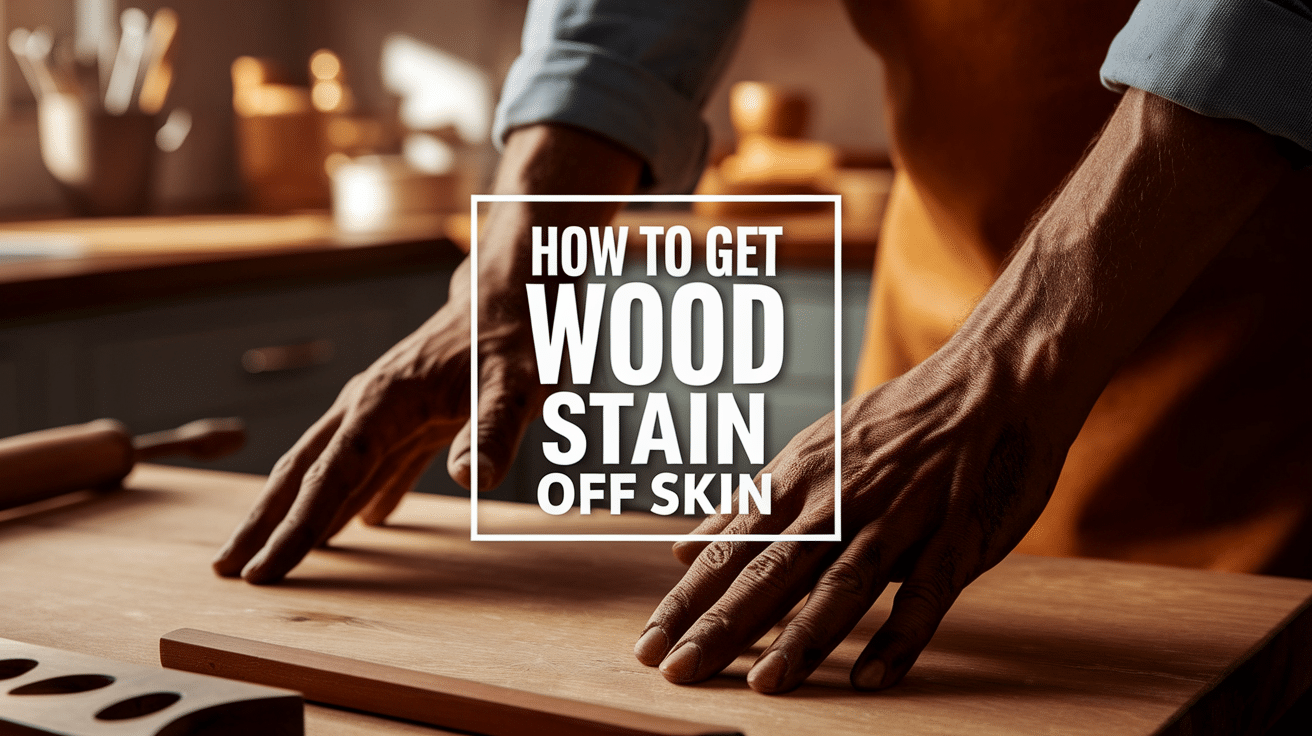Wood stain adheres to skin because its pigments and binding agents penetrate the top layers of skin cells.
The chemicals in stains, particularly oil-based varieties, can bond with proteins in your skin, making them difficult to wash off with just water.
Leaving wood stain on your skin for extended periods isn’t recommended as some products contain harmful chemicals that can irritate skin or be absorbed into your bloodstream.
Additionally, the longer stain remains on your skin, the harder it becomes to remove. This guide provides practical and safe methods to remove wood stain from your skin without causing damage or irritation.
With the right approach, you can effectively clean your skin while minimizing potential health risks!
Why Wood Stain is Hard to Remove from Skin

Wood stains come in two main types: oil-based and water-based. Oil-based stains contain pigments suspended in oils and solvents that bond strongly with skin proteins and natural oils.
Water-based stains use acrylic resins that dry quickly but may be easier to remove when fresh.
Your skin’s porous nature readily absorbs stains, especially oil-based ones. The outer layer of skin (epidermis) has tiny openings that allow stain components to penetrate beyond the surface.
This penetration worsens the longer stain remains on skin, as it continues to bind with skin cells. For this reason, immediate action works best—waiting even just 30 minutes can make removal significantly more challenging.
Avoid harsh chemicals like
- Paint thinners
- Bleach
- Pure acetone
- Gasoline
- Kerosene
They can damage skin. Always test any method on a small area first. Those with skin conditions should use gentler approaches.
Effective Methods to Get Wood Stain Off Skin
When dealing with stubborn wood stains on your skin, you need practical solutions that work without causing irritation.
These tested methods range from common household items to specialized products, giving you options for any situation.
1. Dish Soap and Warm Water

This basic method works on fresh water-based stains by using the grease-fighting power of dish soap to lift pigments before they set into skin.
What to do:
- Wet hands with warm water
- Apply a generous amount of dish soap
- Scrub for 2 minutes, focusing on stained areas with a washcloth
- Use firm but gentle pressure
- Rinse thoroughly and repeat if needed
2. Baking Soda and Dish Soap Paste

The mild abrasion from baking soda paired with soap creates a powerful paste that scrubs away stubborn stain particles.
What to do:
- Combine 1 tablespoon each of baking soda and dish soap in a small bowl
- Apply paste to stained skin
- Gently scrub with a soft cloth for 1-2 minutes
- Rinse with warm water
- Apply moisturizer
3. White Vinegar Soak

Vinegar’s acidity breaks chemical bonds in wood stain without damaging skin, making it effective for stains that have had time to set.
What to do:
- Pour white vinegar onto a clean cloth until damp
- Press against stained skin for 5-10 minutes
- Scrub gently with soap and water afterward
- Repeat process if stain remains visible
4. Olive Oil or Coconut Oil

Natural oils dissolve oil-based stains by binding with the pigments, making them easier to wipe away without harsh chemicals.
What to do:
- Apply 1 teaspoon of olive or coconut oil to stained area
- Massage for 3-5 minutes using circular motions
- Wipe excess with a clean cloth
- Wash with soap and warm water
5. Rubbing Alcohol (Isopropyl)

This powerful solvent quickly dissolves most stain types but can dry skin, so limit contact time and moisturize afterward.
What to do:
- Dampen a cotton ball with rubbing alcohol
- Gently rub stained skin for 30 seconds
- Wash immediately with soap and water
- Apply moisturizer afterward to prevent drying
- Do not use on broken skin
6. Lemon Juice and Salt Scrub

The combination of acidic lemon juice and mildly abrasive salt creates a natural scrub that lightens and lifts stains.
What to do:
- Squeeze half a lemon into a small bowl
- Add 1 tablespoon of salt and mix until paste forms
- Apply to stained areas and gently scrub for 1-2 minutes
- Rinse thoroughly with water
- Avoid using on cuts or broken skin
7. Toothpaste with a Cloth or Brush

The fine abrasives in white toothpaste help lift surface stains while its detergents clean without damaging skin layers.
What to do:
- Apply pea-sized amount of white toothpaste to stained area
- Rub gently with soft cloth or old toothbrush for 1 minute
- Rinse thoroughly with warm water
- Check results and repeat if needed
8. Sugar or Coffee Grounds Exfoliation

These natural granules provide gentle physical exfoliation to remove stained skin cells without the harshness of chemical removers.
What to do:
- Mix 1 tablespoon of sugar or coffee grounds with 1 teaspoon of oil or soap
- Rub mixture on stained skin using circular motions for 2 minutes
- Rinse thoroughly with warm water
- Apply moisturizer afterward
9. Makeup Remover Wipes (Oil-Based)

These wipes contain oils specifically designed to break down pigments and are already embedded in a convenient cloth for application.
What to do:
- Wipe stained area firmly with oil-based makeup remover wipe for 30-60 seconds
- Use a new section of the wipe as needed
- Wash with soap and water afterward to remove any oil residue
10. Pumice Soap

This specialized soap contains fine volcanic rock particles that physically remove stains while the soap base helps lift away residue.
What to do:
- Wet hands with warm water
- Rub pumice soap between hands for 30-60 seconds, focusing on stained areas
- Use light pressure to avoid skin irritation
- Rinse thoroughly with warm water
- Apply moisturizer to prevent dryness
When to Seek Medical Help
Despite careful cleaning attempts, sometimes professional medical attention is necessary. Watch for these warning signs:
- Redness, swelling, or rash that persists or worsens after cleaning attempts
- Pain, burning sensation, or itching that doesn’t subside
- Stain that doesn’t fade after multiple removal attempts
- Any skin changes like blistering or peeling
Children have more sensitive skin and may absorb chemicals more readily, so consult a pediatrician if a child has significant stain exposure.
People with pre-existing skin conditions should also seek medical advice before attempting aggressive removal methods.
Final Thoughts
Removing wood stain from skin requires prompt action and the right approach based on stain type.
From simple soap and water to specialized methods like oil treatment or gentle exfoliation, you have multiple options that don’t require harsh chemicals.
Remember that prevention is always best—wearing gloves during staining projects protects your skin completely. For future projects, consider applying a barrier cream to exposed skin before working with stains.
If the stain persists after 2-3 days despite your best efforts, or if you notice any concerning skin reactions, don’t hesitate to consult a healthcare professional for advice specific to your situation.
Taking a few minutes to identify the type of stain can save your skin from irritation and make removal much more effective!


